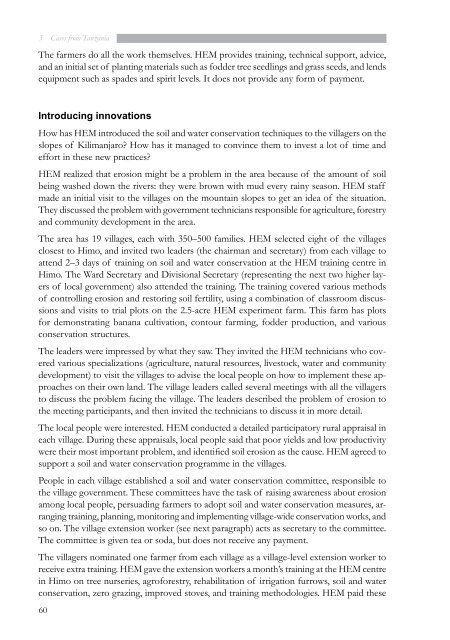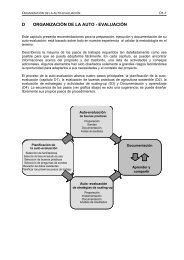cases from tanzania - Sustainet
cases from tanzania - Sustainet
cases from tanzania - Sustainet
Create successful ePaper yourself
Turn your PDF publications into a flip-book with our unique Google optimized e-Paper software.
3 Cases <strong>from</strong> Tanzania<br />
The farmers do all the work themselves. HEM provides training, technical support, advice,<br />
and an initial set of planting materials such as fodder tree seedlings and grass seeds, and lends<br />
equipment such as spades and spirit levels. It does not provide any form of payment.<br />
introducing innovations<br />
How has HEM introduced the soil and water conservation techniques to the villagers on the<br />
slopes of Kilimanjaro? How has it managed to convince them to invest a lot of time and<br />
effort in these new practices?<br />
HEM realized that erosion might be a problem in the area because of the amount of soil<br />
being washed down the rivers: they were brown with mud every rainy season. HEM staff<br />
made an initial visit to the villages on the mountain slopes to get an idea of the situation.<br />
They discussed the problem with government technicians responsible for agriculture, forestry<br />
and community development in the area.<br />
The area has 19 villages, each with 350–500 families. HEM selected eight of the villages<br />
closest to Himo, and invited two leaders (the chairman and secretary) <strong>from</strong> each village to<br />
attend 2–3 days of training on soil and water conservation at the HEM training centre in<br />
Himo. The Ward Secretary and Divisional Secretary (representing the next two higher layers<br />
of local government) also attended the training. The training covered various methods<br />
of controlling erosion and restoring soil fertility, using a combination of classroom discussions<br />
and visits to trial plots on the 2.5-acre HEM experiment farm. This farm has plots<br />
for demonstrating banana cultivation, contour farming, fodder production, and various<br />
conservation structures.<br />
The leaders were impressed by what they saw. They invited the HEM technicians who covered<br />
various specializations (agriculture, natural resources, livestock, water and community<br />
development) to visit the villages to advise the local people on how to implement these approaches<br />
on their own land. The village leaders called several meetings with all the villagers<br />
to discuss the problem facing the village. The leaders described the problem of erosion to<br />
the meeting participants, and then invited the technicians to discuss it in more detail.<br />
The local people were interested. HEM conducted a detailed participatory rural appraisal in<br />
each village. During these appraisals, local people said that poor yields and low productivity<br />
were their most important problem, and identified soil erosion as the cause. HEM agreed to<br />
support a soil and water conservation programme in the villages.<br />
People in each village established a soil and water conservation committee, responsible to<br />
the village government. These committees have the task of raising awareness about erosion<br />
among local people, persuading farmers to adopt soil and water conservation measures, arranging<br />
training, planning, monitoring and implementing village-wide conservation works, and<br />
so on. The village extension worker (see next paragraph) acts as secretary to the committee.<br />
The committee is given tea or soda, but does not receive any payment.<br />
The villagers nominated one farmer <strong>from</strong> each village as a village-level extension worker to<br />
receive extra training. HEM gave the extension workers a month’s training at the HEM centre<br />
in Himo on tree nurseries, agroforestry, rehabilitation of irrigation furrows, soil and water<br />
conservation, zero grazing, improved stoves, and training methodologies. HEM paid these<br />
60




